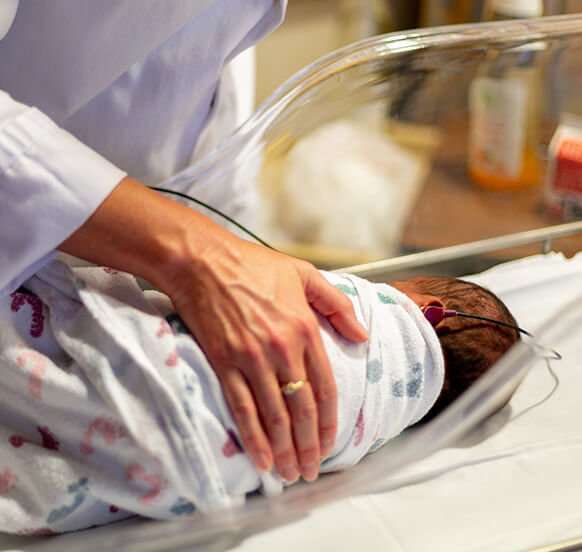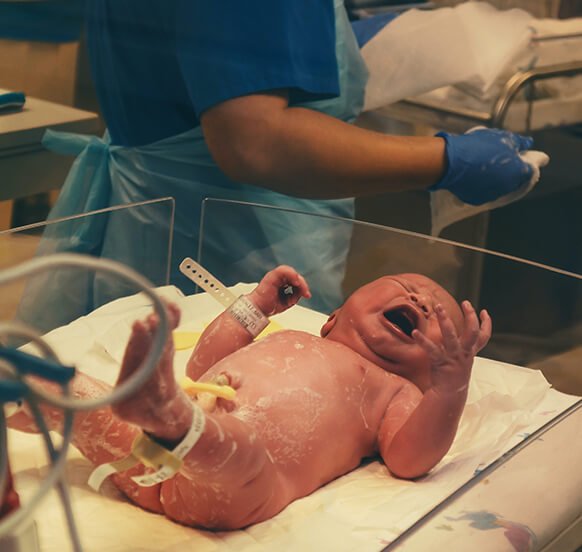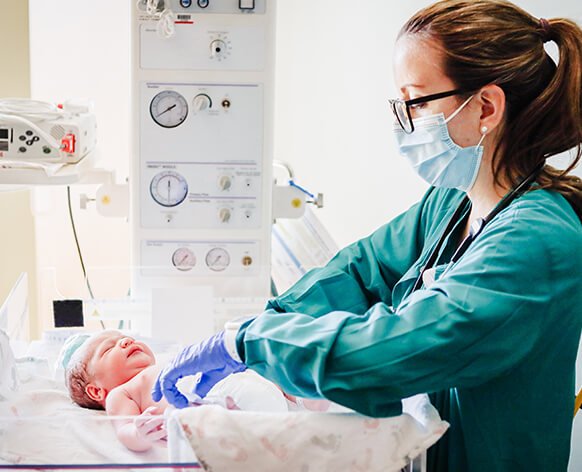Birth Injuries
Sometimes it is because the baby is born with an undiagnosed birth defect. Sometimes, however, the baby is a victim of a birth injury that occurs during labor and delivery.
Giving birth is one of the most exciting events in a mother’s life. Parents prepare for the big day when their new baby is born, and they hope and pray for a healthy baby. Sometimes babies are born with medical problems that don’t match their parents’ expectations. Sometimes it is because the baby is born with an undiagnosed birth defect. Sometimes, however, the baby is a victim of a birth injury that occurs during labor and delivery.
At Thomas & Wan, our lawyers have represented many Texas families who have suffered injuries to their baby as a result of gross negligence and malpractice. We are very familiar with the medicine, the law and the policies of hospitals all across Texas concerning the need for monitoring and possible emergency delivery of laboring moms to prevent injuries to babies. Many times these injuries are preventable if hospitals only ensured that safety policies were followed by their labor nurses, midwives and doctors or ensured that competent and trained nurses were present. Hospitals, doctors, midwives, nurses and medical staff are responsible for making sure a baby is delivered into the world as healthy and as safely as possible and without injuries caused by medical malpractice. When hospitals know that they don’t have trained nurses or midwives or that policies aren’t being followed, this conscious indifference can set up a laboring mom for a tragic outcome—a serious, preventable injury to her baby.
Thomas & Wan’s medical malpractice attorneys have represented numerous children and parents of injured children in birth injury cases and know the specialized medicine and law needed to help your family. We handle cases involving the following types of birth injuries:
Birth Defects Versus Birth Negligence
A birth defect is a health problem that affects your baby based on your child’s genetic material or DNA. Examples of birth defects are Down’s Syndrome, a cleft palate, a heart murmur, or other health problems stemming from baby’s genetics. A birth defect is generally NOT medical malpractice.
In some cases, birth defects can be caused during pregnancy such as when pregnant women take certain medications such as some anti-depressant drugs, anti-nausea medications and even some birth control medications. In these cases, the birth defects could have been prevented had the drug companies warned of the risks or had the doctor not prescribed these types of medications during pregnancy.
On the other hand, a birth injury is a medical issue that an infant is born with that is, in most cases, completely preventable. The most common types of preventable birth injuries are caused by:
A difficult delivery, however, is something that an experienced doctor should be able to avoid. Another way that a birth injury happens to your child is from medical negligence, and sometimes medical negligence could be something as simple as a doctor not viewing the imaging materials properly (namely the ultrasound, but other medical images of the baby could likewise suffice) and thus preventing a difficult birth. In fact, most birth injuries happen because of a difficult labor.
Several birth injuries and difficult labors could be prevented just by monitoring the size of the baby in proportion to the birth canal, seeing what position the baby was in weeks before labor, and whether the umbilical cord and placenta were in proper health and in healthy positions. Difficult labors commonly result in shoulder dystocia, Erb’s palsy and the associated arm problems, or in brain injuries due to a lack of oxygen, blindness, paralysis, not meeting developmental milestones, or even wrongful death.
Birth injuries are serious. If you think your child may be the victim of a birth injury, it’s important to consult other doctors such as neurologists as quickly as possible. Some of the long-term consequences of a birth injury can be lessened the quicker that medical attention is brought to the child.
Thomas & Wan Case Example #1: Lack Of Oxygen To The Brain During Labor
The lawyers of Thomas & Wan are experienced in representing babies who have suffered lack of oxygen to the brain during mom’s labor. Hypoxic Ischemic Encephalopathy (HIE) is a type of brain damage that occurs when an infant’s brain doesn’t receive enough oxygen. It is a dangerous condition that requires immediate medical intervention. HIE is caused by a reduction in the supply of oxygen to the brain and other organs (hypoxia) along with low blood flow to vital organs (ischemia). Since this is considered a brain injury, the time of the oxygen deprivation generally relates to the perinatal period, just before and just after delivery.
HIE is the leading cause of infant fatalities in the United States, as well as the primary source of severe impairments.
There are a number of symptoms associated with HIE, including:
Tests to confirm HIE after symptoms have been assessed include: CT scan, MRI scan, echocardiography, and ultrasound. Optional tests may include electrocardiogram (EKG), electroencephalogram (EEG), and evoked potential tests. Generally, patients are evaluated on whether they have mild, moderate, or severe symptoms of HIE and the condition is controlled from there.
The conditions of HIE vary, depending on whether the infant has mild, moderate, or severe symptoms. There are several different kinds of treatment, some that merely address emergency symptoms and keep your child alive, but there are others that try to reverse or diminish the brain damage.
Most of the time, babies with mild symptoms can have a life uninhibited by HIE, whereas babies with severe symptoms may have a shortened lifespan with a number of painful problems.
Effects of HIE may include developmental delays, epilepsy, cognitive issues, motor skill development delays, and neurodevelopment delays. The true severity of HIE generally cannot be determined until the baby reaches three to four years of age.
HIE can affect babies during labor and delivery, and certain medical problems can lead to conditions that result in HIE include:
In addition, Infants can suffer from the effects of HIE in the postpartum period. Premature babies are particularly at risk of suffering brain injury or even death if HIE occurs after delivery. The most common causes of postpartum HIE include:
Thomas & Wan Case Example #2: Overuse Of Induction Drugs During Labor
At Thomas & Wan, we have the knowledge to pursue cases involving induced labor against hospitals, nurses, midwives and doctors. There are several drugs that are commonly used inducing labor. When these drugs are used in moderation, and mom and baby are closely monitored, and these types of drugs can be safe and effective. When these drugs are given in high doses or without proper monitoring, they can be very dangerous and life-threatening to both mom and baby.
Some induction drugs are administered during labor and delivery to strengthen contractions or control postpartum bleeding. Unfortunately, the inappropriate administration of induction drugs can have serious adverse consequences. Overusing these drugs can cause the mother’s contractions to become too frequent and/or too strong, also known as uterine hyperstimulation. This can interrupt the blood flow to the baby and deprive the infant of vital oxygen. It can also cause life-threatening conditions in the mother, such as a ruptured uterus.
A hospital’s failure to follow its induction policies, the nurses’ failure to monitor laboring moms and babies for hyperstimulation and the insistence of doctors in inducing labor when it is not medically appropriate can put a laboring mom and baby at very high risk for a birth injury from the induction, leading to an emergency C-section, possible hypoxia and brain damage to the baby.
Thomas & Wan Case Example #3: Improper Management Of Gestational Diabetes
Pregnant moms need to take gestational diabetes seriously, and so do doctors and midwives. Gestational diabetes can affect the health of both the mother and baby. To prevent birth complications, it is important for doctors to monitor an expectant mother’s blood sugar and provide appropriate treatment. If a doctor does not carefully manage a pregnant mom’s blood sugar levels, gestational diabetes can lead to a number of health complications, including:
You are more likely to develop gestational diabetes during the later stages of your pregnancy. It typically does not cause any noticeable symptoms. For this reason, it is important for doctors to be proactive in evaluating your risk for gestational diabetes and providing proper treatment and care to manage blood sugar levels. Treatment for gestational diabetes includes dietary changes, exercise and, if necessary, medication. The failure to monitor a pregnant mom’s blood sugar levels can cause the baby to grow very large which can be dangerous during a vaginal delivery. A large baby can have problems being delivered during a vaginal delivery resulting in possible shoulder dystocia, Erb’s palsy, subgaleal hemorrhage, malposition, delayed labor, which could lead, in some cases, to a serious birth injury including hypoxia and brain injury.
Legal Help for The Youngest Victims
At Thomas & Wan, we have the training, experience and knowledge to sue grossly negligent hospitals, doctors, nurses and midwives for birth injuries. Please call us today for free—we are here to listen to you and guide you in the right direction whether you have a birth injury malpractice lawsuit or just have questions.



